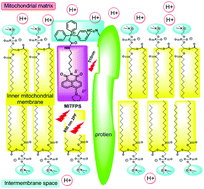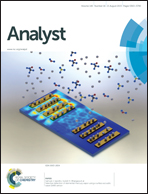Bipolar and fixable probe targeting mitochondria to trace local depolarization via two-photon fluorescence lifetime imaging†
Abstract
Polarization/depolarization levels of different single mitochondria in a cell are inhomogeneous, and always varying. Because depolarization is an indicator of mitochondrial dysfunction, tracing local depolarization is highly desirable. The existing fluorescent probes, however, are not well suited for this task, although they are applicable to assess the average polarization extents of whole cells. A multifunctional and bipolar probe MITFPS is thus developed, which includes a positively charged hydrophilic group and an environment sensitive fluorophore. In the probe design, the hydrophilic anchoring unit is chemically immobilized on a membrane protein, while the lipophilic fluorophore can be inserted deep into the phospholipid layer. The probe exhibits a sensitive response to the local variation in polarization by changing its fluorescence lifetime. MITFPS's applicability is confirmed by real-time in situ imaging of the complete process of an uncoupler-induced depolarization under a two-photon fluorescence lifetime microscope. The imaging result reveals that one mitochondrion could have quite different polarization than the other, even though they are in the same cell.


 Please wait while we load your content...
Please wait while we load your content...